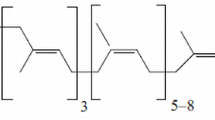Abstract
Sponge-induced exudate from the rat and saline extracts of normal rat liver and rat liver damagedin situ by dimethylnitrosamine have been assayed for putrescine, spermidine and spermine levels. The three physiological oligoamines have been examined for anti-inflammatory activity by the carrageenan-induced oedema rat model and spermidine and putrescine were found to be anti-inflammatory with putrescine being about ten times as active as spermidine. Putrescine was also anti-inflammatory in the adjuvant arthritic rat model.
Thioacetamide and theophylline were also anti-inflammatory and theophylline doubled the level of putrescine in rat liver. It was concluded that putrescine was a potent anti-inflammatory factor in the inflammatory exudates and extracts examined.
Similar content being viewed by others
References
T.H. Rindani,Recovery of an anti-inflammatory fraction from inflammatory exudate, Indian J. med. Res.44, 673–676 (1956).
G.D. Pasquale, R.J. Gired, V.L. Beach andB.G. Steinetz,Antiphologistic action of granuloma pouch exudates in intact or adrenalectomised rats, Am. J. Physiol.205, 1080–1082 (1963).
R.H. Persellin,Lysosome stabilization by adjuvant arthritis serum, Arthritis Rheum.15, 144–152 (1972).
D.A. Lewis, R.B. Capstick andR. Best,The control of rheumatic disease by endogenous protein, Biochem. Pharmac.25, 1435–1436 (1976).
K.H. Hempel, L.A. Fernandez andR.H. Persellin,Effect of pregnancy sera on isolated lysosomes, Nature225, 955–956 (1970).
M.E.J. Billingham, B.V. Robinson andJ.M. Gaugas,The anti-inflammatory components in antilymphocytic serum, Nature227, 276–277 (1970).
M.E.J. Billingham, B.V. Robinson andJ.M. Robson,Partial purification of the anti-inflammatory factors in inflammatory exudate, Br. J. Pharmac.35, 543–557 (1969).
R.S. Pinals,Effect of hepatic injury on adjuvant arthritis, Ann. rheum. Dis.32, 471–474 (1973).
B.V. Robinson andJ.M. Robson,Production of an anti-inflammatory substance at a site of inflammation, Br. J. Pharmac.23, 420–432 (1964).
R.B. Capstick, D.A. Lewis andJ.A. Cosh,Naturally occurring factors in the synovial fluids of patients with rheumatic disease and their possible mode of action, Ann. rheum. Dis.34, 213–218 (1975)
M.E.J. Billingham, A.H. Gordon andB.V. Robinson,Role of the liver in inflammation, Nature, New Biol.231, 26–27 (1971).
D.C. Atkinson andR. Hicks,Relationship between the anti-inflammatory and irritant properties of inflammatory exudate, Br. J. Pharmac.41, 480–487 (1971).
D.C. Atkinson andR. Hicks,The possible occurrence of endogenous anti-inflammatory substances in the blood of injured rats, Br. J. Pharmac.53, 85–91 (1975).
E.D. Maguire andR.B. Wallis,The role of bacterial contamination in the isolation of apparent anti-inflammatory factors from rabbit anti-lymphocytic serum, Br. J. Pharmac.59, 261–268 (1977).
M.J.H. Smith, A.W. Ford-Hutchinson andJ.R. Walker,Anti-inflammatory activity of bacterial endotoxin, J. Pharm. Pharmac.29, 702–704, (1977).
D.A. Lewis, R. Best, J. Bird andD.P. Parrott,Formation of anti-inflammatory proteins following liver damage in rats. In Proceedings of the 7th International Congress of Pharmacology, p. 335 Paris (1978).
J. Bird andD.A. Lewis,Some possible mechanisms of action of an endogenous anti-inflammatory protein. Br. J. Pharmac.66, 455P (1979).
J. Bartholeyns, J.R. Fozard andN.J. Prakash,Dexamethasone inhibition of carrageenin paw oedema in the rat required de novo synthesis of putrescine, Br. J. Pharmac.72, 182–183P (1981).
B.V. Robinson andJ.M. Robson,Further studies on the anti-inflammatory factor found at a site of inflammation. Br. J. Pharmac.26, 372–384 (1966).
D.A. Lewis, J. Bird andR. Best,Anti-inflammatory action following liver damage in the rat, Agents and Actions9, 201–204 (1979).
N.V. Seiler andA. Askar,A micro method for the quantitative estimation of putrescine in tissues, J. Chromat.62, 121–127 (1971).
N.V. Seiler andM. Wiechmann,Die Mikrobestimmung von Spermin und Spermidin a/s-Dimethylamino-napthalin-5-sulfunsciure-Derivate, Hoppe-Seyler's, Z. physiol. Chem.48, 1285–1290 (1967).
C.A. Winter, E.A. Risley andG.W. Nuss,Carrageenan induced oedema in hind paws of the rat as an assay for anti-inflammatory drugs. Proc. Soc. exp. Biol. Med.111, 544–547 (1962).
J.M. Harris andP.S.J. Spencer,A modified plethysmographic apparatus for recording volume changes in the rat paw. J. Pharm. Pharmac.14, 464–466 (1962).
B.B. Newbould,Chemotherapy of arthritis in rats by mycobacterial adjuvant, Br. J. Pharmac.21, 1–10 (1963).
S.P. Liyanage, H.L.F. Curry andB. Vernon-Roberts,Influence of tubercle aggregates size on severity of adjuvant arthritis in the rat, Ann. rheum. Dis.34, 49–53 (1975).
G.R. McKinney andP.M. Lish,On the anti-inflammatory activity of aminophylline, Proc. Soc. exp. Biol. Med.117, 280–283 (1964).
J. Bird andD.A. Lewis,A relationship between putrescine and the anti-inflammatory activity of sponge exudate, Br. J. Pharmac.72, 204P (1981).
V. Bachrach, The induction of ornithine decarboxylase in normal and neoplastic cells. InPolyamines in Biomedical Research, pp. 81–107 (Ed.J.M. Gaugas). J. Wiley and Sons, New York 1980.
J.S. Heller andE.S. Cannellakis, Minimal requirements for the induction of the antizyme to ornithine decarboxylase. Inpolyamines in Biomedical Research, pp. 135–145 (Ed.J.M. Gaugas). J. Wiley and Sons, New York 1980.
B. Weiss andR.M. Levin inAdvances in Cyclic Nucleotide Research, vol. 19 p. 285 (EdsW.J. George andL.J. Ignarro). Raven Press, New York 1978.
W.T. Beck, R.A. Bellantone andE.S. Cannellakis,The in vivo stimulation of rat liver ornithine decarboxylase by dibutyryl c-AMP, theophylline and dexamethasone Biochem. biophys. Res. Comm.48, 1649–1655 (1972).
R.J. Flower andG.J. Blackwell,Anti-inflammatory steroids induce biosynthesis of a phospholipase A 2 inhibitor which prevents prostaglandin generation. Nature278, 456–459 (1979).
Author information
Authors and Affiliations
Rights and permissions
About this article
Cite this article
Bird, J., Mohd-Hidir, S. & Lewis, D.A. Putrescine — a potent endogenous anti-inflammatory substance in inflammatory exudates. Agents and Actions 13, 342–347 (1983). https://doi.org/10.1007/BF01971486
Received:
Issue Date:
DOI: https://doi.org/10.1007/BF01971486



